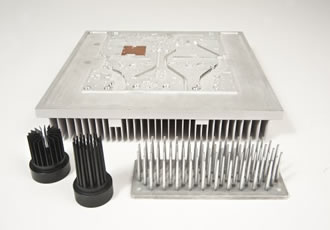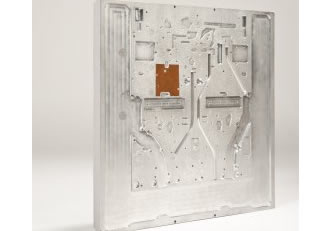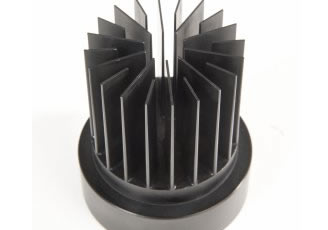High Density Die Casting process for high thermal performance aluminium heat sinks and liquid cold plates

Thermal management applications such as heat sinks, electronics enclosures, leak tight liquid cold plates etc. require characteristics such as high thermal conductivity, low porosity, leak tightness, and the ability to fabricate thin walls and tall fins.
EMBEDDED INSERTS & SURFACE FEATURES
Copper, graphite or other solids with lower CTE than aluminium can be embedded directly into the part. The process yields a strong mechanical bond with almost no interfacial gap or porosity. Surface features such as ribs, bosses and pockets on heat sink bases mate with electronics components and mounting hardware.
THIN AND HIGH ASPECT RATIO FINS
High Density Die Cast heat sinks offer several important advantages over their machined, die cast and extruded counterparts. The increased thermal performance coupled with the ability to expand the fin configurations, fin thickness and shapes of the heat sink are unique advantages for example pin fins, oblique or elliptical fins etc. and radial fin arrays. Many of these features cannot be achieved via extrusion or standard die casting techniques. Further, the process will allow heat dissipation fins to be formed on thinner and lighter wall electronics housings and enclosures with intricate features and low mass.
ENHANCED POST FORMING PROCESSES
Machining without exposing porosity, brazing, and porosity free welding processes enable leak tight complex assemblies. Wet surface finishing processes like anodizing and electroplating can be done without electrolyte retention in surface porosity.

In particular, liquid cold plates made using the HDDC process have a number of desirable attributes:
Uniform temperature distribution: The die casting like capability to make 3D fins and coolant channels and improvements in geometry features like fin thickness, draft angles, and higher conductivity alloys allows optimisation of the flow path for more uniform temperature.
High Volume Production: Like die-casting, the process should be suitable for high volume production including pre-fabricated inserts of copper, stainless steel or other metals for heat spreading or threaded inserts or fittings for fluid connections.
Totally reliable: Parts made with Al 6XXX alloys can be easily CAB or vacuum brazed, to form a 3D perfectly sealed LCP.

Similar articles
More from Aavid Thermoalloy
- Pulsating heatpipe systems have been launched 17th July 2017
- High Density Die Casting process for high thermal performance aluminium heat sinks and liquid cold plates 1st September 2015
- A new intelligent cooling concept from Aavid Thermalloy 17th February 2015












Write a comment
No comments